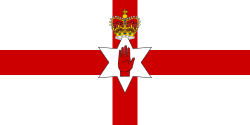Northern Ireland general election, 1969
| | |||||||||||||||||||||||||||||||||||||||||||||||||||||||||||
| |||||||||||||||||||||||||||||||||||||||||||||||||||||||||||
| |||||||||||||||||||||||||||||||||||||||||||||||||||||||||||
|
| |||||||||||||||||||||||||||||||||||||||||||||||||||||||||||
| Election results by constituency. | |||||||||||||||||||||||||||||||||||||||||||||||||||||||||||
| |||||||||||||||||||||||||||||||||||||||||||||||||||||||||||
 |
| This article is part of a series on the politics and government of Northern Ireland 1921–72 |
The Northern Ireland general election, 1969 was held on Monday 24 February 1969. It was the last election to the Parliament of Northern Ireland before its abolition by the Northern Ireland Constitution Act 1973.
Unlike previous elections that produced a large unambiguous majority for the Ulster Unionist Party, this one give more complex results. The Ulster Unionists were divided over a variety of reforms introduced by Prime Minister Terence O'Neill and this division spilled over into the election with official Ulster Unionist candidates standing either in support of or opposition to O'Neill and a number of independent pro O'Neill Unionists standing against opposing candidates. The results left O'Neill without a clear majority for his reforms and he resigned not long afterwards.
This was the first (and only) election since the 1929 election to see changes to the constituencies. The Queen's University of Belfast seat was abolished and four new constituencies were created in the suburbs of Belfast to compensate for population growth there.
Results
| Northern Ireland General Election 1969 | |||||||||||||||
|---|---|---|---|---|---|---|---|---|---|---|---|---|---|---|---|
| Candidates | Votes | ||||||||||||||
| Party | Standing | Elected | Gained | Unseated | Net | % of total | % | № | Net % | ||||||
| UUP | 44 | 36 | 4 | 4 | 0 | 69.2 | 48.2 | 269,501 | -10.9 | ||||||
| Independent Unionist | 18 | 3 | 3 | 0 | + 3 | 5.8 | 15.6 | 86,052 | +15.6 | ||||||
| NI Labour | 16 | 2 | 1 | 1 | 0 | 3.8 | 8.1 | 45,113 | -12.3 | ||||||
| Nationalist | 9 | 6 | 0 | 3 | - 3 | 11.5 | 7.6 | 42,315 | -0.6 | ||||||
| National Democratic | 7 | 0 | 0 | 1 | - 1 | 4.6 | 26,009 | -0.1 | |||||||
| People's Democracy | 8 | 0 | 0 | 0 | 0 | 4.2 | 23,645 | +4.2 | |||||||
| Independent | 4 | 3 | 3 | 1 | + 2 | 5.8 | 3.9 | 21,977 | +3.9 | ||||||
| Protestant Unionist | 5 | 0 | 0 | 0 | 0 | 3.8 | 20,991 | +3.8 | |||||||
| Republican Labour | 5 | 2 | 1 | 1 | 0 | 3.8 | 2.4 | 13,115 | +1.4 | ||||||
| Liberal | 2 | 0 | 0 | 1 | - 1 | 1.3 | 7,337 | -2.6 | |||||||
| People's Progressive | 1 | 0 | 0 | 0 | 0 | 0.5 | 2,992 | +0.5 | |||||||
Electorate: 912,087 (778,031 in contested seats); Turnout: 71.9% (559,087).
